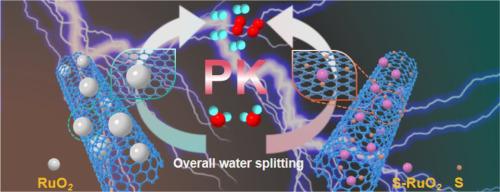Sulphur anion induced electronic structure regulation of RuO2 nanodots for efficient electrocatalytic overall water splitting
IF 14.3
1区 材料科学
Q1 MATERIALS SCIENCE, MULTIDISCIPLINARY
引用次数: 0
Abstract
Developing bifunctional electrocatalysts with enhanced efficiency for both hydrogen evolution reaction (HER) and oxygen evolution reaction (OER) remains a significant challenge. Herein, we constructed S-doped ultra-fine RuO2 nanodots that were uniformly dispersed on carbon nanotubes. The incorporation of S effectively induces local rearrangement of the electronic structure of RuO2, thereby enhancing the dispersion of RuO2 as active sites and optimizing the adsorption free energy of H* intermediate. As expected, the as-synthesized S-RuO2/CNT delivers remarkable HER activity in all pH electrolytes, achieving lower overpotentials of 136, 159, and 396 mV at 100 mA cm−2 in acidic, neutral, and basic solutions, respectively. Moreover, a unitary S-RuO2/CNT electrolytic cell requires only a lower voltage (1.476 V) to achieve a current density of 10 mA cm−2 in 1.0 mol/L KOH. This ingenious work represents a significant breakthrough in the rational design of bifunctional electrocatalysts, enabling remarkable performance in electrochemical water electrolysis.

硫阴离子诱导的RuO2纳米点的电子结构调控用于高效电催化整体水分解
开发出同时用于析氢反应(HER)和析氧反应(OER)的高效双功能电催化剂仍然是一个重大挑战。在此,我们构建了s掺杂的超细RuO2纳米点,并将其均匀地分散在碳纳米管上。S的加入有效地诱导了RuO2电子结构的局部重排,从而增强了RuO2作为活性位点的分散性,优化了H*中间体的吸附自由能。正如预期的那样,合成的S-RuO2/CNT在所有pH电解质中都具有出色的HER活性,在酸性、中性和碱性溶液中分别在100 mA cm - 2下实现了较低的过电位,分别为136、159和396 mV。此外,一个单一的S-RuO2/CNT电解电池只需要一个较低的电压(1.476 V)就可以在1.0 mol/L KOH下实现10 mA cm−2的电流密度。这项独创性的工作代表了双功能电催化剂合理设计的重大突破,使电化学水电解的性能显著。
本文章由计算机程序翻译,如有差异,请以英文原文为准。
求助全文
约1分钟内获得全文
求助全文
来源期刊

Journal of Materials Science & Technology
工程技术-材料科学:综合
CiteScore
20.00
自引率
11.00%
发文量
995
审稿时长
13 days
期刊介绍:
Journal of Materials Science & Technology strives to promote global collaboration in the field of materials science and technology. It primarily publishes original research papers, invited review articles, letters, research notes, and summaries of scientific achievements. The journal covers a wide range of materials science and technology topics, including metallic materials, inorganic nonmetallic materials, and composite materials.
 求助内容:
求助内容: 应助结果提醒方式:
应助结果提醒方式:


